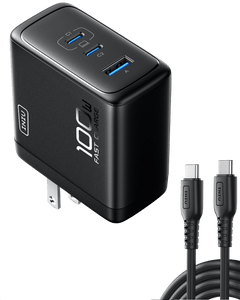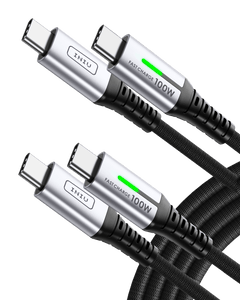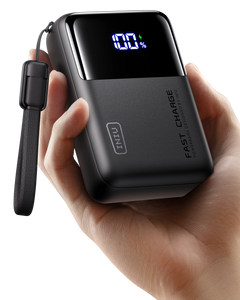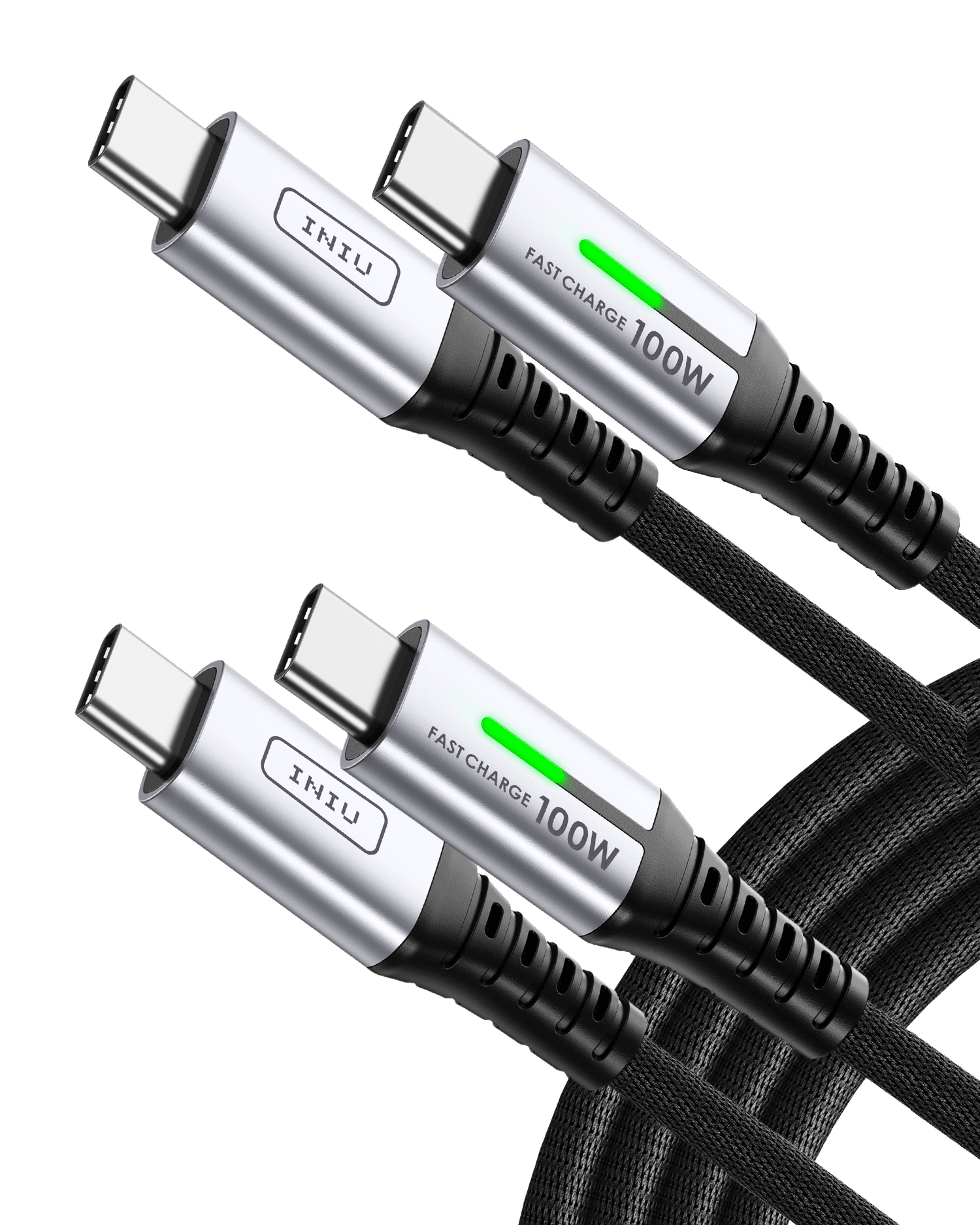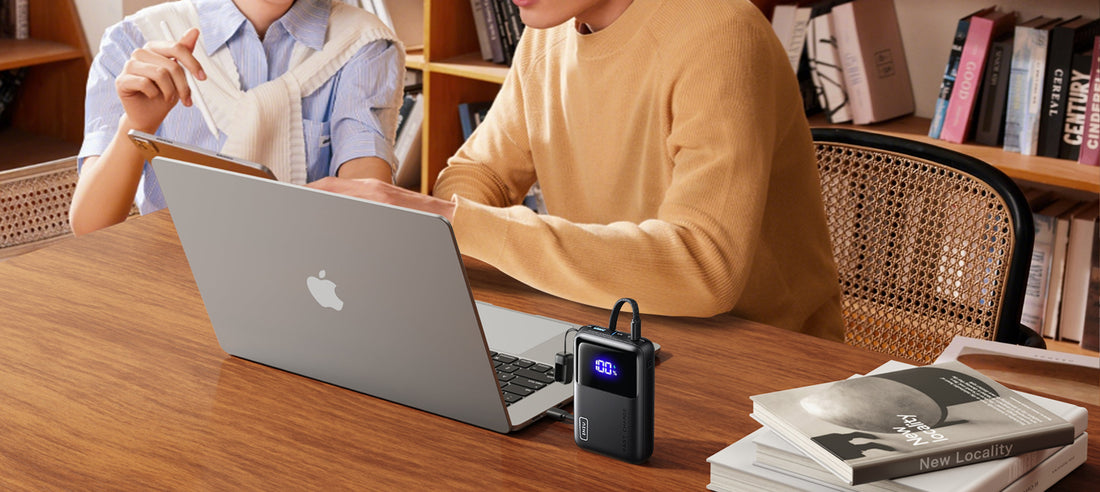
Laptop Not Charging? Your Complete Guide For Laptop Charging
There's nothing more frustrating than plugging in your laptop, only to see the charging light refuse to turn on or the battery icon remain stubbornly stuck. Is it the cable? The charger? Or something worse? Your productivity grinds to a halt, and a wave of anxiety sets in.
We've all been there. But before you start pricing new laptops, take a deep breath. In most cases, the solution is simple and inexpensive. This comprehensive guide will walk you through everything you need to know. We'll help you diagnose the problem with a step-by-step checklist, demystify the technology behind charging gear, help you choose the right laptop charger or power bank for laptop, and teach you how to keep your battery healthy for years to come.
"Why Isn't My Laptop Charging?" A Step-by-Step Checklist

Before you panic or spend any money, let's systematically identify the culprit. Follow these simple steps, starting with the easiest and most common fixes first.
Step 1: Check the Absolute Basics
It might sound obvious, but these simple oversights are surprisingly common causes of charging failures.
Is the Wall Outlet Working? This is the first thing to check. Unplug your laptop charger and plug in a device you know works, like a lamp or your phone charger. If that device doesn't get power, you've found your problem: a dead outlet or a tripped circuit breaker.
Are All Connections Secure? A modern laptop charger often has multiple connection points. Ensure the power cord is firmly plugged into the wall outlet. Check that the cord is securely connected to the power adapter (the "brick"). Finally, make sure the connector is pushed all the way into your laptop's charging port. A slightly loose connection is a frequent issue.
Bypass the Power Strip. If you're using a power strip or surge protector, it could be faulty or switched off. Plug your charger directly into a wall outlet you know is working to rule out the power strip as the problem.
Step 2: Inspect Your Charging Equipment
If the outlet is fine, the next step is to give your charging gear a thorough physical inspection.
The Power Adapter (Brick): Look for an indicator light on the adapter itself. If it has one and it's not lit, the adapter is likely dead. Check the casing for any signs of physical damage, cracks, discoloration, or melting plastic. A faint burning smell is a definitive sign that the adapter has failed and is a fire hazard. Unplug it immediately.
The Charging Cable: This is the most common point of failure. Carefully run your fingers along the entire length of the cable, from the brick to the connector. Feel for any cuts, kinks, or exposed wires. Pay extra close attention to the flexible joints at both ends of the cable, as this is where they endure the most stress and are most likely to fray.
The Connector Pin/Port: Examine the metal tip that plugs into your laptop. For older barrel-style connectors, is the center pin bent, broken, or wobbly? For a usb c laptop charger, use a light to look inside the metal housing. Is it clogged with lint or debris? Is the internal plastic tab cracked?
Step 3: Investigate the Laptop Itself
If your charging equipment looks fine, the issue might be with the laptop.
The Charging Port: Shine a bright light into your laptop's charging port. Over time, dust, lint from a backpack, and other debris can get packed in there, preventing a solid connection. To clean it safely: Power down your laptop completely. Use a non-metallic tool like a wooden or plastic toothpick to gently scrape out any debris. A can of compressed air can also work wonders, but be sure to use short bursts to avoid moisture buildup.
Perform a Power Cycle (Hard Reboot): Sometimes, a temporary software or hardware glitch can prevent the system from recognizing the charger. To fix this:
- Shut down the laptop completely.
- Unplug the charger.
- If your laptop has a removable battery, take it out.
- Press and hold the power button for 30 seconds. This drains any residual charge from the motherboard.
- Re-insert the battery (if you removed it), plug the charger back in, and try to turn the laptop on.
(Note: Many new laptops require tools to remove the battery. If you find it difficult to do this, ask a professional for help and do not attempt it yourself.)
Check for Overheating: Laptops have built-in safety mechanisms to prevent battery damage. If your machine is extremely hot to the touch (e.g., from gaming or being left in a hot car), it may temporarily disable charging. Let it cool down in a well-ventilated area for 30 minutes and try again.
Step 4: Software and Driver Issues
Less common, but still possible, are software-related problems. The following are some possible checks, but they require more professional skills to complete. If you are not sure, please do not do it yourself and seek help from professionals.
Update Battery Drivers (Windows): Open Device Manager, expand the "Batteries" section, right-click on "Microsoft ACPI-Compliant Control Method Battery," and select "Uninstall device." Don't worry; when you restart your laptop, Windows will automatically reinstall it.
Update BIOS/UEFI: Your laptop's BIOS/UEFI is the low-level firmware that controls the hardware. Manufacturers sometimes release updates that fix charging-related bugs. Warning: This is an advanced step. Only download BIOS updates from your laptop manufacturer's official website and follow their instructions precisely, as a mistake here can render your laptop unusable.
Step 5: When to Call a Professional
If you have tried all the steps above with a known-good charger and your laptop still won't charge, the problem is likely internal. The two most common culprits are a completely dead battery that can no longer hold a charge, or a faulty DC-in jack or motherboard charging circuit. At this point, it's time to contact the manufacturer's support or a reputable local computer repair shop for a diagnosis.
Demystifying the Tech - A Buyer's Guide to Laptop Charging Gear

Choosing a replacement or a spare charger can be a minefield of confusing terms and specifications. Let's break down what you need to look for to make a safe and smart purchase.
Understanding the Holy Trinity: Watts (W), Volts (V), and Amps (A)
You'll find these numbers printed in tiny text on your original charger's label. They are the key to compatibility.
Simple Analogy: Think of electricity like water flowing through a pipe.
- Volts (V) are the water pressure.
- Amps (A) are the width of the pipe.
- Watts (W) are the total amount of water flowing out per second (Watts = Volts x Amps). This is the total power your laptop needs. The rule is simple: your new charger's wattage must be equal to or greater than the wattage of your original charger. A 90W laptop will charge perfectly fine with a 100W charger (it will only draw the 90W it needs), but it will charge slowly or not at all with a 45W charger.
- Volts (V): This should ideally match your laptop's requirement exactly.
- Amps (A): The charger's amp rating should be equal to or greater than the original.
You can find your laptop's required wattage, voltage, and amperage on the original laptop charger or often on a label on the bottom of the laptop itself.
The USB-C Revolution: Power Delivery (PD) Explained
The biggest source of confusion today is USB-C. "Can I use my phone's USB-C charger for my laptop?" The answer is almost always no, and here's why.
For a USB-C port to charge a laptop, it needs a technology called USB Power Delivery (PD). Standard USB-C ports on phone chargers output low wattage (5W-20W). A USB-C PD charger, however, is a smart device. It communicates with your laptop to "negotiate" the correct voltage and amperage for fast and safe charging. Besides, a high-power charger that supports PD can support charging of mobile phones and laptops at the same time.
When buying a usb c laptop charger or a type c laptop charger, you must ensure it explicitly supports Power Delivery (PD) and has a high enough wattage for your device.
How to Choose the Right Power Adapter (Charger)
OEM vs. Third-Party: An OEM (Original Equipment Manufacturer) charger is one made by your laptop's brand (e.g., Dell, Apple). It guarantees perfect compatibility but is often expensive. High-quality third-party brands like INIU are excellent, often more compact, and more affordable alternatives.
Safety First: NEVER buy cheap, unbranded chargers from suspicious online marketplaces. These are often made with substandard components and lack critical safety features, making them a serious fire hazard.
Connector Type: Double-check that the connector physically matches your laptop, whether it's a specific barrel connector, a proprietary magnetic one like MagSafe, or the universal USB-C.
GaN Technology Advantage: When choosing a charger, consider one powered by GaN (Gallium Nitride) technology. GaN chargers use advanced semiconductor materials that allow for higher efficiency, faster charging, and smaller size compared to traditional silicon-based adapters. They also generate less heat, making them safer and more durable for long-term use. For instance, GaN chargers from INIU combine compact design with robust protection features, delivering maximum power output without overheating.
How to Choose the Right Charging Cable
For USB-C: The cable itself is just as important as the charger! A cheap USB-C cable designed for a phone is likely not rated to handle the high power a laptop needs. When buying a replacement, look for a cable that is explicitly rated for the wattage you need. For example, to get the full benefit of a 100W charger, you need a cable that is rated for 100W power delivery.
Durability and Nylon Braiding: One of the most common failure points for any charging cable is fraying near the connector head. To combat this, we strongly recommend investing in a high-quality, nylon-braided cable. The woven fabric exterior provides superior resistance to bending, twisting, and daily wear and tear. It reinforces the vulnerable joint between the cable and the connector, dramatically increasing the cable's lifespan and saving you money in the long run.
How to Choose the Right Power Bank for Your Laptop
For those who often need to work outside or use laptops on the go, a wall plug alone is not enough. The new high-power power bank provides the possibility of charging laptops on the go. Here's what you need in a laptop power bank.
Check the USB-PD: It MUST have a high-wattage USB-C PD output. A power bank for laptop is essentially a portable battery combined with a smart charger. The key feature is a USB-C port that supports Power Delivery. A standard USB-A port will not charge your laptop.
Check the Output Wattage: This is the most critical spec. You need to match the power bank's output to your laptop's needs.
- 45W-60W: A 45w power bank is perfect for some ultrabooks and lightweight laptops. This includes devices like MacBook Air, and some Chromebooks. They are a great balance of portability and power.
- 65W-90W: This is the sweet spot for most lightweight 14-inch and 15-inch laptops. They provide enough power to charge the laptop even while it's under a moderate workload.
- 140W+: For power users with demanding machines. If you have a 16-inch MacBook Pro, you need a high-output portable laptop charger 140w model. These power banks can handle the high energy draw of these devices and charge them efficiently.
Check the Capacity (mAh/Wh): Capacity, measured in milliamp-hours (mAh) or Watt-hours (Wh), tells you how much energy the power bank holds. A 20,000mAh power bank is a good starting point and can typically provide one full charge for an ultrabook. 25,000mAh is a common size as it's often the maximum capacity allowed on airplanes.
Airline Regulations: Most airlines restrict lithium-ion batteries in checked luggage and have a limit for carry-on. The limit is typically 100Wh (Watt-hours). You can calculate your power bank's Wh rating with the formula: (mAh * V) / 1000 = Wh. Some brands list the Wh rating directly on the device, making it easy to verify compliance.
Best Practices for Safe Charging and Long Battery Life

Once you have the right gear, using it correctly will protect your investment and extend your battery's lifespan.
Daily Charging Safety Tips
Don't Use Damaged Cords: A frayed or exposed cable is not just an inconvenience; it's a fire and electrical shock hazard. Replace it immediately. It's not worth the risk.
Keep it Cool: Your charger and laptop both generate heat while charging. Never cover your power adapter with blankets, pillows, or books. Ensure there is good airflow around your laptop, especially if you're using it while it's plugged in. Don't use your laptop on a soft surface like a bed, as it can block the cooling vents.
Avoid "Daisy-Chaining": Plug your charger directly into a wall outlet or a high-quality, certified surge protector. Avoid plugging it into cheap, multi-way extension cords, which may not be rated for the power draw and can be a fire risk.
Maximizing Your Laptop Battery's Lifespan
Modern lithium-ion batteries are consumables; they will degrade over time. But with proper care, you can significantly slow down that process.
Myth Busting: "Is it bad to leave my laptop plugged in all the time?" The short answer is no, it's not as bad as it used to be. Modern laptops are smart enough to stop charging once the battery reaches 100%. You cannot "overcharge" it. However, the real enemies of battery longevity are heat and staying at 100% charge constantly. A battery under constant high voltage (at 100%) and high temperature will degrade faster.
The 20-80 Rule: For optimal longevity, the sweet spot for a lithium-ion battery is to be kept between 20% and 80% charge. If you primarily use your laptop plugged in, check your manufacturer's software. Many now include a "battery care" or "conservation" mode that limits the maximum charge to 80%, which is ideal for extending its lifespan.
Avoid Deep Discharges: Regularly letting your battery drain completely to 0% puts significant stress on it. Try to plug it in before it drops below 20%.
Store it Properly: If you know you won't be using your laptop for several weeks or months, don't store it fully charged or fully empty. Charge it to around 50%, power it off completely, and store it in a cool, dry place.
Frequently Asked Questions
Q: Can I use any USB-C charger for my laptop?
A: No. Only chargers that support USB Power Delivery (PD) can safely and effectively charge laptops. Standard phone chargers output low wattage (typically 5W–20W), while laptops often require 45W–100W or more. Always choose a PD-certified USB-C charger with wattage equal to or higher than your laptop's requirement.
Q: Are third-party chargers safe to use?
A: Yes—if they're from reputable brands that comply with safety certifications (UL, CE, FCC). Brands like INIU offer compact, high-quality alternatives that are as reliable as OEM chargers but more affordable. Avoid cheap, unbranded adapters that may overheat or damage your device.
Q: What's special about GaN chargers?
A: GaN (Gallium Nitride) technology allows chargers to deliver higher power in a much smaller and cooler form factor. They're more energy-efficient, charge faster, and are safer for long-term use. A GaN USB-C PD charger is an excellent investment for professionals or frequent travelers.
Q: Can a power bank charge my laptop?
A: Yes—if it supports high-wattage USB-C PD output (45W or higher). A phone power bank won't work for laptops. Look for capacity around 20,000–25,000mAh for full laptop charging and ensure it's airline-approved (under 100Wh). INIU and other top brands offer reliable, compact laptop power banks with fast-charging capabilities.
Q: How can I make my laptop battery last longer?
A: Avoid deep discharges and extreme heat. Keep your battery between 20% and 80%, enable "battery care" mode if available, and avoid leaving it plugged in constantly at 100%. Storing it at about 50% charge in a cool, dry place can also extend lifespan.



